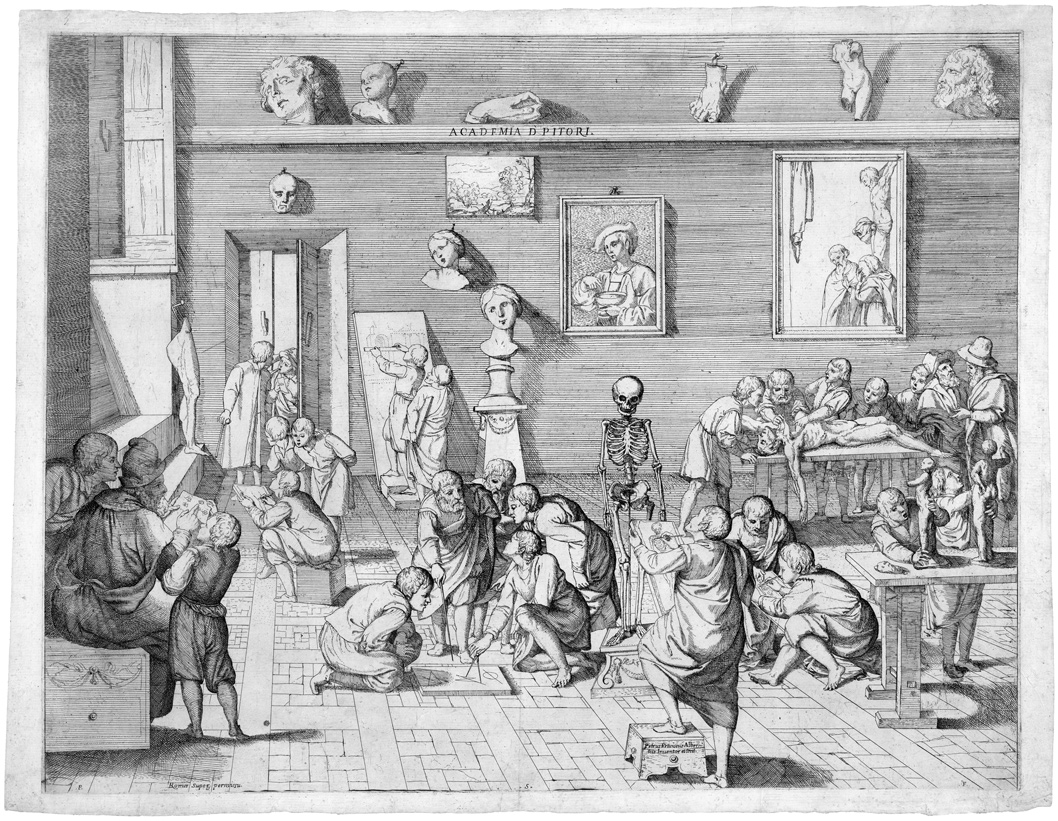Loading the page ...
Pietro Francesco Alberti
(1584 Borgo San Sepolcro or Rome – 1638 Rome)
Academia D’ Pitori. Etching. 40.5 x 52.8 cm. B. XXVII, 313, 1.
The painter and engraver Pietro Francesco Alberti was a descendant of a large, well-known family of artists who originated from Borgo San Sepolcro. He worked almost exclusively in Rome, where he was a member of the Accademia di S. Luca. This delightful, large-scale depiction of a painting academy is the only print the artist ever made and therefore a precious rarity.
The composition owes its appeal to the wealth of sensitively and humorously observed details. We see a spacious hall in which students and teachers, in keeping with the artistic theories of the Renaissance, are engaged in a large number of different disciplines, such as mathematics, anatomy, architecture, sculpture and drawing. Through the wide-open window daylight streams into the sparsely furnished interior. On the left, a young student presenting a letter of recommendation is being admitted to the vast classroom. Fragments of ancient sculpture and plaster casts stand on a shelf or are fastened to the wall by a nail. The three paintings hanging on the wall symbolize the different genres of religious painting, portraiture and landscape painting. In an exemplary way the individual disciplines are shown, which art students had to complete in order to develop into artists with an all-round humanist education.
In his choice of compositional motifs Alberti was probably greatly influenced by Cornelis Cort’s print The Practice of the Visual Arts (The New Hollstein III, 210). This engraving, published in Rome in 1578 after a drawing by Johannes Stradanus (British Museum, London), shows several related iconographical elements, such as the human skeleton slightly left of centre and the corpse undergoing dissection behind it. However, while Stradanus selected an upright format, in which the individual motifs are all crowded together, Alberti’s composition is conceived horizontally and arranged much more spaciously so that everything can be clearly discerned.
There is a lot going on in Alberti’s academy and the hall must have fairly buzzed with activity. In the left foreground an older artist is showing two students a sheet from a model book illustrating eyes. In 16th century art teaching and in the model books of that epoch paramount importance was attached to the drawing of the human face, especially the eyes, this being considered the beginning of any artistic activity. Interestingly enough, Stradanus’ preliminary drawing for Cornelis Cort’s engraving also shows at far left a boy drawing eyes. In the engraved version, however, the boy’s sheet of paper is covered with neutral, horizontal lines (see Michael Bury, The Print in Italy 1550–1620, London 2001, pp. 18–21). Hans Collaert’s depiction of an artist's studio from the famous series Nova reperta, which is equally based on an invention by Stradanus, also shows in the right foreground a young student engaged in the same activity.
Other iconographical motifs in the foreground are the study of mathematics, whose composition is derived straight from Raphael’s School of Athens; drawing from a human skeleton (analogous to Cort’s engraving); and the modelling of the human figure. In the right background, regardless of the surrounding bustle, a corpse is calmly being dissected. In a bizarre detail the fragmentary representation of the Crucifixion over the dissecting table shows Christ without forearms and Mary and John only to the hip. Finally, the discipline of architecture is illustrated to the right of the door. Everything is treated in a light and spiritual etching technique, which makes this work a charming and unusual document of the teaching practices of the early seicento.
A splendid, clear and harmonious impression with subtle plate tone, with even margins around the distinct platemark. Minor ageing, otherwise in very good condition.
